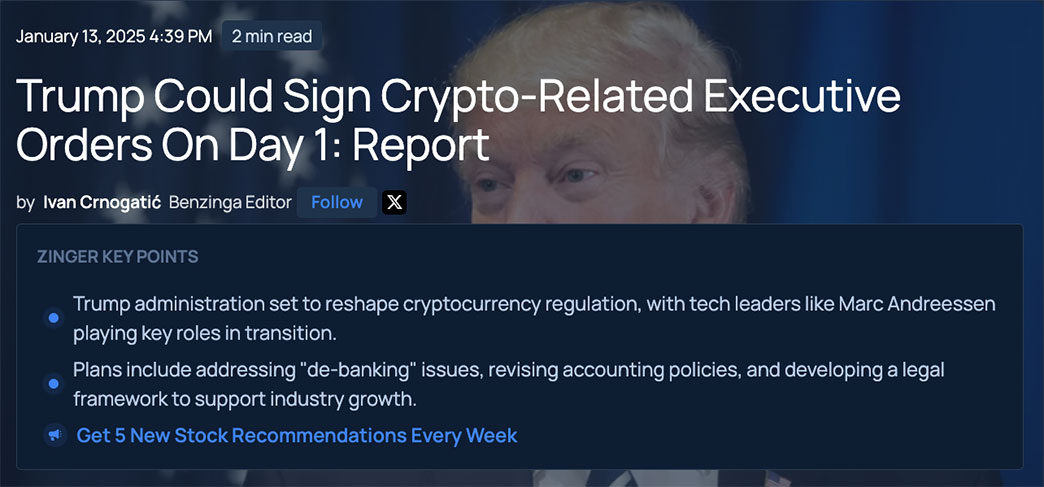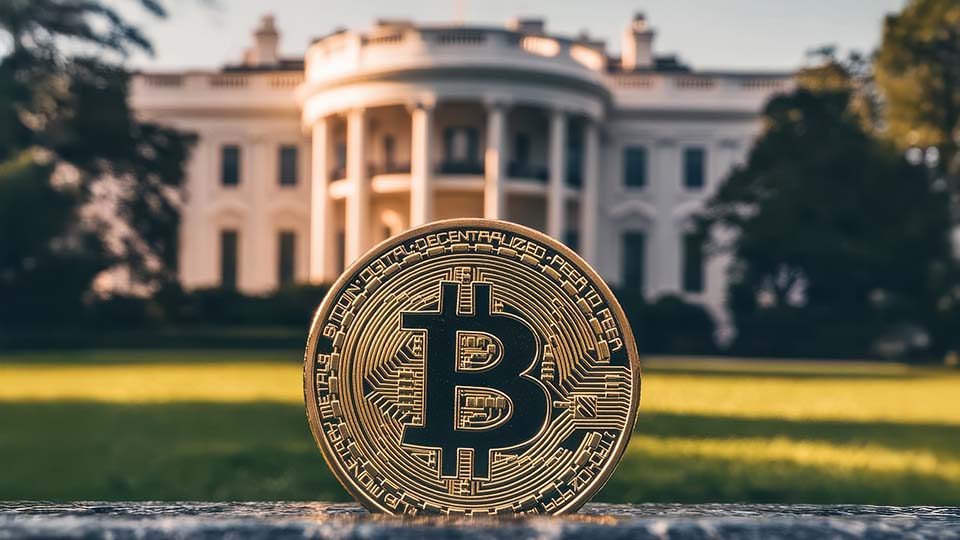What Trump's Presidency Will Mean for Bitcoin
17 January 2025
Read Time 7 MIN
The reelection of Donald Trump as President of the United States marks a pivotal moment for the cryptocurrency landscape, particularly Bitcoin. With Trump's administration signaling shifts in regulatory priorities, market sentiment, and economic strategies, investors and enthusiasts are bracing for what could be a transformative period. Below, we explore the implications of Trump's presidency for Bitcoin.
Trump's Evolving Stance on Bitcoin
Historically, Trump's views on Bitcoin have ranged from skepticism to cautious optimism. While he once called Bitcoin a threat to the U.S. dollar, recent statements indicate a more nuanced perspective. At the Nashville Bitcoin Conference, Trump floated the idea of creating a federal Bitcoin reserve—a policy that could legitimize Bitcoin's role as a global asset. His administration's pro-business ethos suggests a potential reduction in regulatory friction, fostering a more favorable environment for cryptocurrency innovation.
This shift aligns with recent market movements, where Trump's reelection triggered a surge in memecoins in November 2024, reflecting renewed investor confidence. His pro-crypto cabinet appointments have further fueled optimism about Bitcoin's future in a regulatory-friendly environment.
Regulatory Clarity: A Double-Edged Sword
Trump's presidency could bring significant regulatory changes. Key appointments, such as the newly appointed SEC Chair Paul Atkins, known for his deregulatory stance, may end the "regulation by enforcement" era. This shift could benefit Bitcoin by increasing clarity for institutional investors. However, with greater adoption and legitimization may come heightened scrutiny. Proposed tax reforms and updated reporting requirements for crypto transactions could add complexity for individual investors.
Several ongoing judicial and legislative developments may support mainstream crypto adoption. The U.S. Appeals Court's ruling to overturn Tornado Cash's OFAC sanctions sets a legal precedent for how immutable smart contracts are treated, distinguishing them as non-ownable, uncontrollable, and not considered "property" under OFAC's definitions. On the legislative side, policies like SAB 121—which restricts banks from holding crypto assets off-balance-sheet—are likely to be repealed within a quarter. Furthermore, reworked stablecoin regulations under Sen. Hagerty's Clarity for Payment Stablecoins Act could pave the way for more privacy-friendly versions, enabling state-chartered banks to issue stablecoins without requiring Federal Reserve approval.
In addition, the executive branch's pro-crypto stance under Trump's leadership brings opportunities for growth. Key figures such as Secretary of the Treasury Scott Bessent have publicly stated that "everything is on the table with Bitcoin," while other prominent cabinet members actively hold crypto assets, signaling alignment with the industry's growth potential. Regulatory developments supporting Ethereum and Solana ETPs in 2025 could also enhance liquidity and attract institutional capital to decentralized applications.
Furthermore, the Trump administration could issue crypto-related executive orders as early as his first day in office. These orders are expected to include directives to:
- Establish a clear national framework for cryptocurrency regulation, creating consistency across federal and state jurisdictions.
- Provide tax incentives for blockchain-based businesses and mining operations to encourage innovation and domestic growth.
- Mandate a review of current SEC and CFTC oversight structures to streamline approvals for cryptocurrency-based financial products, such as ETPs.
- Launch public-private partnerships to accelerate blockchain research and development, with a focus on enhancing U.S. competitiveness in the global digital economy.
By issuing these executive orders, Trump's administration aims to position the United States as a global leader in cryptocurrency and blockchain innovation, sending a strong signal to both institutional investors and industry stakeholders.

Economic Policies and Bitcoin’s Market Dynamics
Trump's economic strategies—characterized by fiscal stimulus and trade realignments—could indirectly influence Bitcoin's trajectory. As government spending rises, concerns about inflation and dollar devaluation may push investors toward Bitcoin as a hedge. Historical trends reveal Bitcoin's correlation with political and economic uncertainty, suggesting a potential price surge in the face of these dynamics.
Moreover, Trump's support for domestic energy production aligns with the interests of Bitcoin miners. By encouraging fossil fuel and nuclear energy use, his administration could lower operational costs for U.S.-based mining operations, solidifying America's position as a global mining leader. Additionally, the possibility of regulatory clarity boosting institutional interest may propel Bitcoin adoption even further.
The Vision of a Federal Bitcoin Reserve
One of the most intriguing possibilities under Trump's presidency is establishing a federal Bitcoin reserve. Proposed by influential figures like Senator Cynthia Lummis, this policy envisions the U.S. Treasury acquiring Bitcoin to bolster its balance sheet. Advocates argue that this move could solidify Bitcoin's role as a strategic reserve asset, similar to gold. While ambitious, such a plan would face logistical and political challenges, including global market reactions and potential accusations of dollar manipulation.
We highlight that the potential for a U.S. Bitcoin reserve may offset national debt significantly. According to projections, if the U.S. acquires 1 million BTC by 2029 and Bitcoin grows at a compound annual growth rate (CAGR) of 25%, Bitcoin could represent 35.5% of the national debt by 2049. This strategy assumes Bitcoin acquisition at $200,000 per coin and a deceleration of debt growth from its recent CAGR of 7% to 5%. Emphasizing this assumption ensures transparency in the calculation methodology.
In a more optimistic scenario, with Bitcoin's value reaching $42 million per coin by 2049, a U.S. Bitcoin reserve could represent 36% of the projected $119 trillion national debt. Such a reserve would also comprise 18% of global financial assets, demonstrating Bitcoin's increasing importance in global finance. The accompanying graph highlights the trajectory of the U.S. national debt versus Bitcoin's reserve value, underscoring the substantial fiscal benefits this strategy could offer.
Bitcoin Reserve Value Vs. U.S. National Debt in 2049
Est. U.S. Debt vs BTC Reserve Growth
Source: VanEck research as of December 2024. Past performance is no guarantee of future results. Any information, valuation scenarios, or price targets/projections presented on Bitcoin are not intended as financial advice, a recommendation to buy or sell Bitcoin, or any call to action. There may be risks or other factors not accounted for in these scenarios that may impede the performance of Bitcoin; actual future performance is unknown and may differ significantly from the projections herein. Any projections, forecasts or forward-looking statements included herein are the results of a simulation based on our research, are valid as of the date of this communication and subject to change without notice, are for illustrative purposes only, and are those of the author(s), but not necessarily those of VanEck or its other employees. Please conduct your own research and draw your own conclusions.
Investor Strategies in the Trump Era
For Bitcoin investors, Trump's presidency presents both opportunities and risks. Key strategies to consider include:
- Hedging Against Volatility: As Bitcoin reacts to macroeconomic shifts, maintaining a diversified portfolio with measured Bitcoin exposure can mitigate risks.
- Mining Investments: Investors may explore opportunities in Bitcoin mining operations, particularly in regions benefiting from favorable energy policies.
- Monitoring Regulatory Developments: Staying informed about changes in crypto tax laws and reporting requirements will be crucial for compliance and optimization.
- Tracking Market Sentiment: As we highlighted in our 2025 crypto predictions piece, monitoring metrics like search trends, app rankings, and institutional flows can provide critical insights into market dynamics.
A Balanced Outlook
Trump’s presidency introduces a complex mix of potential catalysts and headwinds for Bitcoin. While pro-business policies and regulatory clarity could drive adoption, the associated risks of centralization and overregulation remain. Bitcoin’s decentralized ethos will continue to be tested as it navigates this new political era.
The Trump administration may prioritize U.S. leadership in blockchain technology, potentially leveraging public-private partnerships to accelerate innovation in the sector.
For investors, the key lies in balancing optimism with caution. By understanding the broader implications of Trump’s policies, preparing for market volatility, and leveraging insights from industry leaders, Bitcoin holders can position themselves to thrive in this evolving landscape.
Links to third party websites are provided as a convenience and the inclusion of such links does not imply any endorsement, approval, investigation, verification or monitoring by us of any content or information contained within or accessible from the linked sites. By clicking on the link to a non-VanEck webpage, you acknowledge that you are entering a third-party website subject to its own terms and conditions. VanEck disclaims responsibility for content, legality of access or suitability of the third-party websites.
Related Insights
Related Insights
03 February 2025




